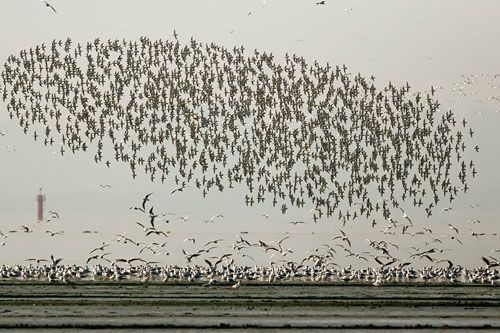Many animals and birds migrate on a regular and predictable basis. In some cases all the entire population of a particular species migrates, typically between breeding and winter locations. In other cases, only a percentage of population chooses to migrate, with some individuals remaining in the same general location. The migrations are triggered by the changes of the season and hence the availability of food and deteriorating climatic conditions. Migratory habits are found in populations of mammals, birds and insects. Some of these migrations are nothing less than staggering, and offer wonderful photographic opportunities..
 |
| Image by kind permission of David Wirawan |
Examples of truly remarkable migrations include that of the Arctic tern that breeds in the Arctic during the northern summer when the hours of daylight are very long, and over-winters in the Antarctic where there are long hours of daylight during the months from November to February. The journey from one area to the other, a distance of 10,000 - 12,000 miles, is undertaken twice each year.. This is the longest migration recorded for any animal or bird.
Migrating birds generally follow broadly-defined routes between their breeding and over-wintering locations determined by factors such as prevailing conditions and the availability of food and water. Snow geese breed between late May and late August, but then migrate to warmer areas for the winter. During the migration period, large flocks of snow geese can be seen following well-defined routes over distances of about 3,000 miles.
The wildebeest of the Serengeti Plain, located in Tanzania and Kenya, follow a clockwise 1,800-mile circular route around the Serengeti determined by the shifting rains and hence the availability of grass on which to feed. The migration involves about 1.5 million wildebeest and 250,000 zebra and gazelle and other animals. The migration is is the largest and most spectacular movement of land mammals anywhere in the world, and is pursued ruthlessly by Africa’s big cats and other predators.
The North American Monarch butterfly spends the summer in various locations throughout the western United States but over-winter by hibernating in oyamel fir trees of the Michoacan state in Mexico. It is the only butterfly known to migrate both north and south in the manner of birds. Their journey is remarkable not only for its 2,000-mile length but also because individual butterflies live no more than about a couple of months. No individual butterfly therefore completes the round trip migration, and the females deposit eggs for the next generation during the migrations.When all of the butterflies assemble within the one valley, the weight of the insects on tree branches is sometimes sufficient to cause them to break.






